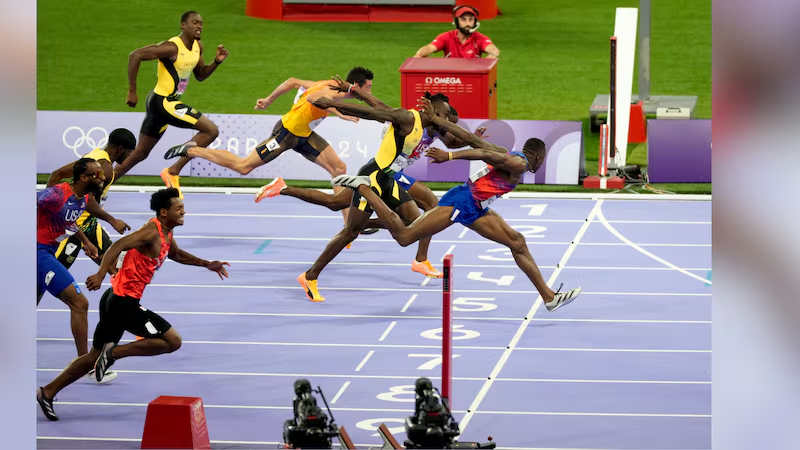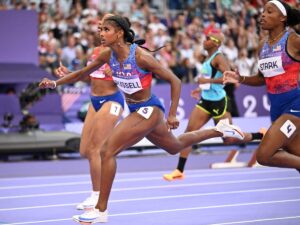Going for Gold in the 100/110 Hurdles
by Steve McGill
In looking at the sprint hurdles at the 2024 Olympic Games in Paris, it seems evident that the United States is stronger than it’s been in quite some time, which is saying something, because the US has always been strong in both events. Of the six possible medals available, the US garnered three, including both golds. The women’s race was hotly contested, but the same cannot be said for the men’s race, at least not to the same degree. Let’s take a look:
[am4show not_have=’g5;’]
[/am4show][am4guest]
[/am4guest][am4show have=’g5;’]
Men’s 110m Hurdles
The men’s 110 hurdles has become the Grant Holloway show. That’s nothing new, but it’s more emphatically true now. He is far and away the best high hurdler in the world, so every race he enters is his to lose. While Holloway has always been an exceptionally impressive athlete, he hasn’t always been an exceptionally impressive hurdler. In the midst of running some mind-blowing races, he’s also had some duds here and there, and has been notorious for struggling in the latter part of races. That tendency cost him big time in the 2021 Tokyo Olympic final, where Hansle Parchment of Jamaica chased him down for the gold even though Holloway went into the meet as a heavy favorite and hadn’t lost a race all year. Holloway was a good sport about it and gave Parchment his due credit, but you can tell he’s been on a mission ever since then.
The biggest improvement I’m seeing lies in his body angles over the

hurdles. He’s holding his lean slightly longer, he’s punching the lead arm down more quickly, and he’s bringing the trail leg to the front more quickly. The improvement in the lead arm / trail leg action is the reason he’s looking stronger later in races. The lead arm used to cross the body a little bit, causing the trail leg to delay a little bit, which caused him to float a little bit. Now that he has fixed that stuff, we’re seeing more consistency overall, and better finishes overall.
Meanwhile, although the competition in the event is hot, it is no longer hot hot hot! Parchment isn’t racing at the level he was three years ago. Devon Allen ran 12.84 in May of 2021 and then left the sport to try to make it as a professional football player, and he hasn’t returned to the hurdle wars since. Hurdlers like Cordell Tinch and Rasheed Broadbell look very good but are still on the come up. Freddie Crittenden has had an outstanding season but he’s not on Holloway’s level. Then there’s Daniel Roberts, who has been Holloway’s rival ever since their collegiate days, but at this point Holloway knows he can beat Roberts any time he puts his mind to it, so the rivalry isn’t really a rivalry anymore.
Funny little anecdote: about thirty seconds after the 110 final ended, I received a text from one of my former athletes whom I hadn’t heard from for over a year, saying, “13 flat???? That’s what wins the Olympics???” I laughed out loud reading that. The official time ended up being 12.99, which of course is very fast but not mind-blowing these days, especially for Holloway. But a sub-13 is still a sub-13, so let’s give the man some credit. Personally, I always think back to the race that made me want to hurdle – Renaldo Nehemiah’s 12.93 in 1981. That time he ran 43 years ago would still win an Olympic final. That’s crazy to think about. Imagine if Nehemiah had worn superfly’s. He would’ve been in the 12.7’s.
In the final, Roberts matched Holloway’s amazing start. (My jaw always drops when I see Holloway blast out of the blocks). But Roberts hit one of the early hurdles, which he is prone to do, and that ended any chances of keeping up with Holloway the whole way. Holloway surged ahead and cruised to victory, although Roberts and Broadbell both closed very well. They both finished in 13.09, with Roberts getting the silver by .003.
Holloway now can add an Olympic gold medal to his three World Championship golds. Put that together with his personal best of 12.81, which is the second-fastest of all time, and you have a good case for calling him the greatest of all time. Now, I’m not saying definitively he’s the greatest of all time, but he’s certainly in the conversation.
Women’s 100m Hurdles
My “arc of a season” theory that I applied to Rai Benjamin’s victory in my article on the men’s 400 hurdles also applies to Masai Russell in the women’s 100 meter hurdles. In the sprint hurdles this theory is even more applicable because the rhythm of the race is so precise and so quick that the ability to time one’s movements exquisitely over ten hurdles becomes paramount. Once you get to that point where everything “clicks,” where the danger of sprinting at hyper speeds doesn’t daunt you, where no matter how crowded you feel you still feel like you’re in control, it’s like you become a new breed of animal.
I know I’m not explaining it very well, but I think you get what I mean. A coaching friend of mine used to refer to it as “dialing in to your rhythm.” It’s a thing where you’re not afraid of your own speed. You’re so in tune with your rhythm that you don’t need to think about speed or technique. It’s like you’re feeling the race while you’re running the race. We saw Russell enter that zone at the Olympic Trials, where she won a hotly contested race in 12.25. That was an electrifying race, an oh damn race that announced her status as a gold medal favorite, even with Jasmine Camacho-Quinn’s looming presence.
The other two Americans, Aylasha Johnson and Grace Stark, who both ran in the low 12.30’s at the Trials, also looked to be legit medal contenders. The one who wasn’t on my radar heading into Paris was the French woman, Cyrena Samba-Mayela. I thought that was because I had been snoozing on non-Americans, showing my American bias, but when I did some research I discovered that she hadn’t really burst onto the scene in a big way until this year. At the European Championships in early June, she dropped her personal best down from 12.52 to 12.31. That’s a big drop, bruh.
In the final, it was Nadine Visser of the Netherlands who got out the fastest and took control of the race, and was leading after four hurdles. Russell’s start was “mid,” as my students would say. She didn’t get left in the blocks but she was toward the back of the pack. But as we saw in the men’s 100 meter dash with Noah Lyles, you have to run the whole race, because the athletes who get out the fastest don’t always finish the strongest. And like Lyles, Russell knew what she could do from line to line, so we saw no panic in her. Johnson made contact with the second hurdle before smacking the third hurdle, effectively knocking her out of contention. The fact that she came back and ran 12.93 after almost falling is quite remarkable in and of itself.

In the middle part of the race is where the three eventual medalists all made a surge. Russell, who looked to be in third at the eighth hurdle, continued to surge, passing both Samba-Mayela and Quinn off the last hurdle on her way to gold in 12.33. Samba-Mayela edged Camacho-Quinn for silver, 12.34 to 12.36. Not quite as fast as the US Trials, but very fast nonetheless. Visser and Stark also ran very impressive races, with both clocking in at 12.43. There was a time not too long ago when 12.4’s would put you on the podium at an Olympic Games. Now it won’t even get you to the Games, as the top six Americans at the US Trials finished under 12.40. As John F. Kennedy once famously said, “The world is very different now.” That quote definitely applies to the women’s 100 meter hurdles.
[/am4show]
